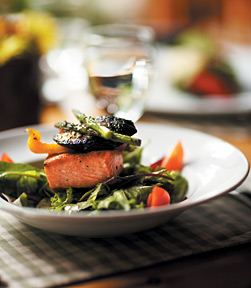The Mediterranean diet also appears to modify the risk for developing cutaneous melanoma.
According to the authors of a 2008 study, "After careful control for several sun exposure and pigmentary characteristics, we found a protective effect for weekly consumption of fish, shellfish, fish rich in n-3 fatty acids, daily tea drinking, a high consumption of vegetables, in particular carrots, cruciferous and leafy vegetables, and fruits, in particular citrus fruits."
A Rational Plan for Skin Health
It is extremely important to avoid excessive exposure that leads to sunburns, particularly when we are young. Otherwise, we should take a graded approach to sun exposure based on our skin pigmentation. For especially fair-skinned people, this may mean only 10 minutes a day without sunscreen. Because it is not normal for humans to spend multiple hours at the beach lying in the sun, after brief sun exposure, the use of sunscreen is required and a beach umbrella is recommended.
 For the average Caucasian individual, it takes only 30 minutes of summer sunbathing to produce 20,000 IU of vitamin D. Viewed another way, 1 minimal erythemal dose causes a slight pinkness to the skin and is equivalent to ingesting approximately 20,000 IU of vitamin D. Substantially longer time is required for darker-skinned individuals to generate such levels, especially very dark-skinned African Americans. In a Minnesota-based study, 100 percent of African Americans, East Africans, Hispanics, and American Indians had deficient levels of serum 25(OH)D. Supplementation with vitamin D is recommended for individuals who cannot get adequate sun exposure.
For the average Caucasian individual, it takes only 30 minutes of summer sunbathing to produce 20,000 IU of vitamin D. Viewed another way, 1 minimal erythemal dose causes a slight pinkness to the skin and is equivalent to ingesting approximately 20,000 IU of vitamin D. Substantially longer time is required for darker-skinned individuals to generate such levels, especially very dark-skinned African Americans. In a Minnesota-based study, 100 percent of African Americans, East Africans, Hispanics, and American Indians had deficient levels of serum 25(OH)D. Supplementation with vitamin D is recommended for individuals who cannot get adequate sun exposure.
While diet may not typically be considered to influence skin health, the evidence suggests the exact opposite. In addition to healthy sun exposure, we must eat a skin-protecting anti-inflammatory diet. For the average person, this means the avoidance of sugar, flour and refined oils, and substantially increased consumption of vegetables and fruit, which provide vital antioxidants and phytonutrients. Talk to your doctor for more information.
David Seaman, MS, DC, DACBN, is the author of Clinical Nutrition for Pain, Inflammation and Tissue Healing. He has a master's degree in nutrition from the University of Bridgeport, Conn., and lectures on nutrition.

